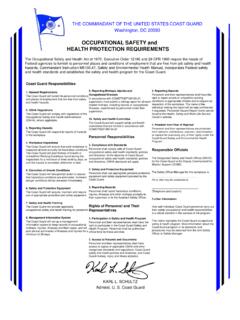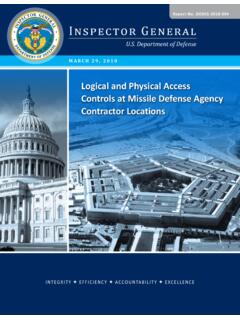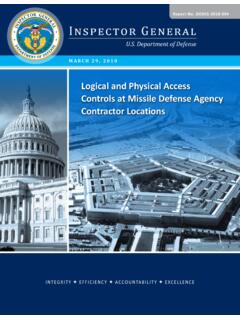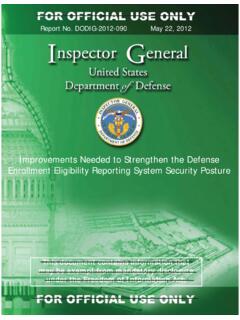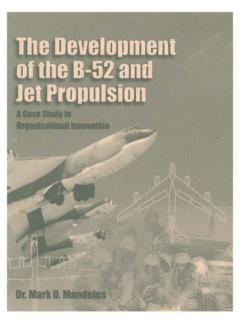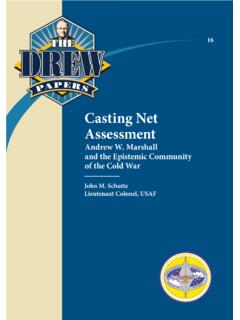Transcription of DoD Cloud Strategy - U.S. Department of Defense
1 UNCLASSIFIED. Department of Defense DoD Cloud Strategy December 2018. UNCLASSIFIED. UNCLASSIFIED. FOREWORD. The Department of Defense (DoD) has entered the modern age of warfighting where the battlefield exists as much in the digital world as it does in the physical. Data and our ability to process data at the ready are differentiators to ensure mission success. Cloud is a fundamental component of the global infrastructure that will empower the warfighter with data and is critical to maintaining our military' s technological advantage. The DoD Cloud Strategy reasserts our commitment to Cloud and the need to view Cloud initiatives from an enterprise perspective for more effective adoption. It recognizes our experience over the past five years and identifies seven strategic objectives along with guiding principles to set a path forward. It emphasizes mission and tactical edge needs along with the requirement to prepare for artificial intelligence while accounting for protection and efficiencies.
2 The Strategy drives implementation toward the enterprise Cloud environment, an ecosystem composed of a General Purpose and Fit For Purpose clouds. It focuses implementation activities on two fundamental types of work: first is the stand up of Cloud platforms ready to receive data and applications, and second is the ongoing work to migrate existing applications and to develop new applications in the Cloud . This effort is a Department priority. As we execute this Strategy , we will continue to seek the active participation and commitment of all DoD Components to realize the benefits of Cloud as we operate on the 21st century battlefield . UNCLASSIFIED. IIll IIIH11111111111. --os0!)16570-18tCM0021275:1 a . UNCLASSIFIED. Table of Contents 1 Strategic Environment .. 1. Inadequate Efficiency and Security in Information Technology .. 1. Disparate Cloud Efforts and Disjointed Implementation.
3 2. Lack of Cloud Fitness .. 2. Readiness for Artificial Intelligence (Al) .. 2. 2 Strategic Objectives .. 3. Enable Exponential Growth .. 3. Scale for the Episodic Nature of the DoD Mission (Elasticity) .. 3. Proactively Address Cyber ChalJenges .. 4. Enable AI and Data Transparency .. 5. Extend Tactical Support for the Warfighter at the Edge .. 6. Take Advantage of Resiliency in the Cloud .. 6. Drive IT Reform at DoD .. 7. 3 Strategic Approaches and Guiding Principles .. 7. Warfighter First .. 7. Cloud Smart-Data Smart .. 8. Leverage Commercial Industry Best Practices .. 8. Create a Culture Better Suited for Modem Technology Evolution .. 8. 4 Implementation .. 9. 5 Conclusion .. 10. Appendix A: Implementation Details .. A-1. General Purpose Cloud : Joint Enterprise Defense Infrastructure .. A-1. Fit-for-Purpose .. A-2. Cloud Migration .. A-2. Governance and .. A-3. Workforce Considerations.
4 A-4. ii UNCLASSIFIED. 1 Strategic Environment "If we fail to adapt .. at the speed , then our military forces .. will lose the very technical and tactical advantages we've enjoyed since World War II ". - Secretary ofDefense James N Mattis Information is vital to United States ( ) national security and our ability to understand emerging threats, project power globally, conduct operations, support diplomatic efforts, and enable global economic viability. The Department of Defense (DoD) has multiple disjointed and stove-piped information systems distributed across modem and legacy infrastructure around the globe leading to a litany of problems that impact warfighters', decision makers', and DoD staffs ability to organize, analyze, secure, scale, and ultimately, capitalize on critical information to make timely, data-driven decisions. Today, the Department is largely constrained by physical resources, manpower limitations, organic skillsets and, oftentimes, laborious contracting processes to procure or grow storage and computing capabilities.
5 In addition, the cyberspace domain continues to be an increasingly contested environment. In order for the to keep its strategic advantage, warfighters and the force that support them need to be provided with the proper capabilities and technologies to succeed. To this end, commercial industry has made significant strides in addressing these challenges that the Department can leverage. Commercial Cloud computing is a subscription-based service that provides network-based storage and compute resources. It allows users to store and access data and programs over the Internet rather than on a local computer hard drive. It also allows users to access information from anywhere at any time, effectively removing the need for the user to be in the same physical location as the hardware that stores the data. The Department must take full advantage of this technology enabler. Inadequate Efficiency and Security in Information Technology The physical information technology (IT) infrastructure deployed across the Department was purchased with a "maximum use" case in mind.
6 In other words, the hardware can support the greatest possible expected demand, regardless of how infrequently that may happen, if at all. This causes much of the physical IT infrastructure purchased to be idle the majority of the time. Commercial Cloud infrastructure works differently. It can scale dynamically to support resource demands with the benefit of only paying for the actual use. During most times, systems can be scaled down to support the minimal traffic that is the norm. By owning and operating the physical hardware associated with on-premises data centers, the Department can incur unnecessary security risks and consume resources that could otherwise be realigned to support warfighters and the workforce in other mission areas. A combination of overly strict policies and procurement procedures make it difficult for DoD to ensure that both hardware and software are updated appropriately.
7 The cost spent on physical hardware has a negative impact on diverting vital resources away from the warfighter and workforce as well as security impacts with a direct burden of responsibility for security updates of both hardware and 1. UNCLASSIFIED. software on DoD. The Department has historically been challenged to keep up with cyber threats to its IT infrastructure. Disparate Cloud Efforts and Disjointed Implementation DoD has not had clear guidance on Cloud computing, adoption, and migration to provide unifying guidance or a coherent plan. This has made it difficult for the Department to embrace modem IT capabilities, to benefit from the efficiency and capacity offered by commercial Cloud services, and to continue to evolve with technology at the speed of relevance. The lack of guidance has led to Departmental inefficiencies and has hindered the Department in IT modernization efforts.
8 It has led to disparate efforts with siloed teams, disjointed implementations with limited capability, siloed data, and inefficient acquisitions that cannot take advantage of economies of scale. Lack of Cloud Fitness DoD has stood up a number of clouds that have not been architected or designed for enterprise use. It is imperative that DoD has a Cloud Strategy to ensure that legacy applications are not moved to Cloud without properly rearchitecting them to make use of the data, security, resiliency, and application advantages that Cloud provides. Additionally, DoD should independently test and assess Cloud network security to verify security compliance and incident response, and review all contractor and third-party testing results to ensure that performance and security monitoring are sufficient. Systems that are not " Cloud ready" will most likely use excessive amounts of Cloud infrastructure resources, meaning they will not be any more efficient and will almost certainly cost more to operate.
9 This is why system rationalization is critical, but, without proper guidance, many program offices may not do this properly or skip it entirely. There is currently no enterprise-wide guidance on how to rationalize a system nor for assessing a system's Cloud readiness. This gap has further led to the siloed data behavior mentioned earlier and restricted the ability of the Department to share information. This enterprise-wide guidance is imperative to the success of any Cloud Strategy - enterprise or otherwise. As DoD has continued to stand up independent clouds, we continue to dilute our already constrained Cloud expertise. This enterprise Cloud Strategy provides the constructs for optimizing our use of Cloud talent. To date, the DoD oftentimes relies on outside contracting firms to perform these assessments, never building the organic corporate knowledge to carry us into the future.
10 Decisions are being made at high levels without in-house technical expertise as advisors. The Department must invest in its own future by building technical knowledge within. Readiness for Artificial Intelligence (Al). As DoD embarks to stand up a Joint Artificial Intelligence Center (JAIC), it will require an enterprise Cloud infrastructure capability. An enterprise Cloud will provide the common data and infrastructure platforms that will enable Al to meet the full promise of warfighter advantage. DoD has created this DoD Cloud Strategy to align with the larger DoD cyber Strategy , strengthening the security and resilience of the networks and systems that contribute to the Department 's military advantage. 2. UNCLASSIFIED. 2 Strategic Objectives DoD will continue to rely on its ability to process and disseminate information for military operations, intelligence collection, and related activities.
